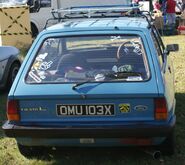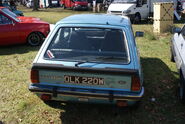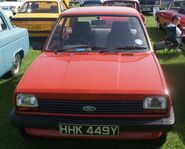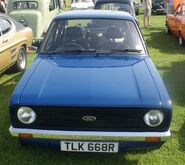
Ford Fiesta
The Ford Fiesta is a front-wheel-drive supermini/subcompact manufactured and marketed by Ford Motor Company and built in Europe, Brazil, Argentina, Mexico, Venezuela, China, India, Thailand and South Africa. The current-generation Fiesta is marketed worldwide.
By 2010, the sixth-generation (Mark VI) Fiesta had been introduced worldwide, including in the United States and Canada—making it the first Fiesta model to be sold in North America since the Fiesta Mark I was discontinued at the end of 1980.
The Fiesta has sold over twelve million units since 1976.
History[]
The Fiesta was originally developed under the project name "Bobcat" (later to be used on a badge engineered version of the Ford Pinto called the Mercury Bobcat) and approved for development by Henry Ford II in September 1972. Development targets indicated a production cost US$100 less than the current Ford Escort. The car was to have a wheelbase longer than that of the Fiat 127, but with overall length shorter than that of Ford's Escort. The final proposal was developed by Tom Tjaarda at Ghia. The project was approved for production in autumn 1973, with Ford's engineering centres in Cologne and Dunton (Essex) collaborating.
Ford estimated that 500,000 Fiestas a year would be produced, and built an all-new factory near Valencia, Spain; a transaxle factory near Bordeaux, France; factory extensions for the assembly plants in Dagenham, UK, and Saarlouis, Germany. Final assembly also took place in Valencia.
Codenames[]
When Ford of Europe began to design the car, the design proposals were named Iris, Beta, The Deutschlander (from Ford's Cologne studios), Mini-Mite, and the Blue Car (from Ghia). Codenames for the Fiesta prototype included Torino, but it became Project Bobcat.
The shortlisted names for the new car designed by the project Bobcat team (headed by Mr Trevor Erskine) were Amigo, Bambi, Bebe, Bravo, Bolero, Cherie, Tempo, Chico, Fiesta, Forito, Metro, Pony and Sierra. Despite more board votes for "Bravo", Henry Ford II personally overruled them and named the car "Fiesta". Several of the shortlisted names were later used on other cars, including "Sierra", which was introduced on the Cortina replacement in 1982, and Tempo which was used on a Ford small car in the United States market. Ironically the "Metro" nameplate was introduced by rival manufacturer British Leyland for the similar-sized Austin Metro in 1980.
The name Fiesta belonged to General Motors at the time; however, it was freely given for Ford to use on their new B-class car. After years of speculation by the motoring press about Ford's new car, it was subject to a succession of carefully crafted press leaks from the end of 1975. A Fiesta was on display at the Le Mans 24 Hour Race in June 1976, and the car was launched and on sale in France and Germany in September 1976: to the frustration of UK dealerships righthand drive versions only began to appear in the UK in January 1977.
Fiesta Mark I (1976–1983)[]
Mechanically, the Ford Fiesta followed tradition, with an end-on four-speed manual transmission mounted to a new version of the Ford Kent OHV engine, dubbed "Valencia" after the brand new Spanish factory in Almussafes, Valencia, developed especially to produce the new car. Ford's plants in Dagenham, England, and Saarlouis and Cologne (from 1979) in Germany, also manufactured Fiestas. To cut costs and speed up the research and development, many modified Kent engines destined for the Fiesta were tested in Fiat 127s – at the time considered the benchmark car in the class, with which the Fiesta shares styling similarities. This also allowed covert road testing across Europe.
Although not the first Ford vehicle to feature front-wheel drive (the 1960s Taunus produced by Ford of Germany laid claim to that title), the Fiesta is widely credited as being Ford's first globally successful front-wheel-drive model. UK sales began in January 1977, where it was available from £1,856 for the basic 950 cc-engined model.
It was only the second hatchback mini-car to have been built in the UK at this stage, being launched a year after the Vauxhall Chevette, but a year before the Chrysler Sunbeam and four years before the Austin Metro. The millionth Fiesta was produced on 9 January 1979.
The car was available in Europe with a 957 cc (58.4 cu in) I4 (high compression and low compression options), either a 1.1 L and 1.3 L OHV petrol engines and in Base, Popular, L, GL (1978 onward), Ghia and S trim, as well as a van. The U.S. Mark I Fiesta was built in Cologne, Germany but to slightly different specifications; U.S. models were Base, Decor, Sport, and Ghia, the Ghia having the highest level of trim. These trim levels changed very little in the Fiesta's three-year run in the USA, from 1978 to 1980. All U.S. models featured the more powerful 1.6 L (98 cu in) Kent inline-four engine (fitted with a catalytic converter and air pump for lower emissions), energy-absorbing bumpers, side-marker lamps, round sealed-beam headlamps, improved crash dynamics and fuel system integrity as well as optional air conditioning (a/c was not available in Europe). In the U.S. market, the Ford Escort replaced both the Fiesta and the compact Pinto in 1981.
At the beginning of the British government's Motability scheme for disabled motorists in 1978, the Fiesta was one of the key cars to be available on the scheme.
A sporting derivative (1.3 L Supersport) was offered in Europe in 1980, effectively to test the market for the similar XR2 introduced one year later, which featured a 1.6 L version of the same engine. Black plastic trim was added to the exterior and interior. The small square headlights were replaced with larger circular ones resulting in the front indicators being moved into the bumper to accommodate the change. With a quoted performance of 0–60 mph (0–97 km/h) in 9.3 seconds and 105 mph (169 km/h) top speed, the XR2 hot hatch became a cult car beloved of boy racers throughout the 1980s.
Minor revisions appeared across the range in late 1981, with larger bumpers to meet crash worthiness regulations and other small improvements in a bid to maintain showroom appeal ahead of the forthcoming Mk 2.
In 1978, the Fiesta overtook the Vauxhall Chevette as Britain's best-selling supermini, but in 1981 it was knocked off the top spot by British Leyland's Austin Metro and was still in second place at the end of 1982.
Gallery[]
Crayford convertibles[]
In 1982, coachbuilders Crayford produced the Fiesta "Fly"—a convertible version of the Mk 1 Fiesta 1300 Ghia, and a total of just fifteen vehicles were produced. The following year the more powerful 1600 Mk 1 Fiesta XR2 was the donor car, and a further seven convertibles were produced. The conversion involved welding the boot shut.
Fiesta Mark II (1983–1989)[]
The Fiesta Mark II appeared towards the end of summer 1983 with a revised front end and interior, and a bootlid mirroring the swage lines from the sides of the car. The 1.3 L OHV engine was dropped, being replaced in 1984 by a CVH powerplant of similar capacity, itself superseded by the lean burn 1.4 L two years later. 957 and 1,117 cc engines continued with only slight alterations and for the first time a Fiesta diesel was produced with a 1600 cc engine adapted from the Escort.
The new CTX continuously variable transmission, also fitted in the Fiat Uno, eventually appeared early in 1987 on 1.1 L models only. This gearbox provided a quick and economic driving experience, despite the resemblance of the sensation of the continuously variable transmission to that of a slipping clutch.
The Mk 2 featured a different dashboard on the lower-series trim levels compared to the more expensive variants.
The XR2 model was thoroughly updated with a larger bodykit. It also featured a 96 bhp (72 kW) 1.6 L CVH engine as previously seen in the Ford Escort XR3, and five-speed gearbox (also standard on the 1.3 L CVH models). The engine was replaced by a lean-burn variant in 1986 which featured a revised cylinder head and carburettor; it was significantly cleaner from an environmental viewpoint but was slightly less powerful as a result (95 bhp/71 kW).
A truly "hot" Fiesta was never produced by the factory to avoid impacting on sales of performance Ford Escort variants but many aftermarket conversions were available, the best-known being that by the English firm Turbo Technics boosting power to a well documented 125 bhp (93 kW), which easily outclassed its "standard" rivals. Ford appreciated the high quality of this conversion and was keen to look after its customers: the installation was undertaken by approved fitting centres and all the warranties remained valid after.
The face-lifted, facing competition from the Vauxhall Nova and Austin Metro, was one of the UK's top supermini. In its best-ever year, 1987, over 150,000 Fiesta models were sold in the UK, though it missed out on first place in the sales charts to the Ford Escort.
The Mk 2 Fiesta lives on as the donor vehicle for Quantum Sports Cars' 2+2 convertible with several hundred manufactured at the factory in Stourbridge before production moved to Kingsbridge.


























